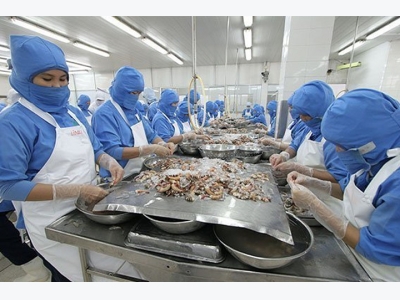Shrimp exports to U.S. seen rebounding in late 2017

Workers process shrimp at a seafood factory in the Mekong Delta. VASEP expects the nation’s shrimp exports to the U.S. market could bounce back in the final four months of 2017 - PHOTO: TRUNG CHANH
Ho Chi Minh City - The Vietnam Association of Seafood Exporters and Producers (VASEP) expects the nation’s shrimp exports to the U.S. market could bounce back in the final four months of 2017.
The U.S. will have a lot of festive events in the coming months, which will drive up demand for seafood, including shrimp, according to VASEP.
VASEP data shows that in the first half of the year, the country’s shrimp shipments to the U.S. fell 5% year-on-year to US$306.5 million, triggered by the anti-dumping duties imposed on Vietnamese shrimp by the U.S. Department of Commerce (DOC) and fiercer competition from India.
However, VASEP said shrimp from all countries, including large exporters like India, Thailand, Indonesia and Ecuador, are also subject to anti-dumping tariffs in the U.S.
VASEP’s forecast is different from that of experts. At the Vietnam Fisheries International Exhibition 2017 (Vietfish 2017) last week, experts projected Vietnam would not be able to see a strong improvement in shrimp exports to the U.S.
In 2016, Vietnam exported nearly US$688 million worth of shrimp to America, becoming the fourth largest shrimp exporter of the U.S. All the three largest shrimp exporters to the U.S. are from Asia, namely India, Indonesia and Thailand.
VASEP has called for shrimp exporting companies to keep to the U.S. quality, manufacturing and processing standards if they are to step up shipments to this huge market.
Related news
Tools

Phối trộn thức ăn chăn nuôi

Pha dung dịch thủy canh

Định mức cho tôm ăn

Phối trộn phân bón NPK

Xác định tỷ lệ tôm sống

Chuyển đổi đơn vị phân bón

Xác định công suất sục khí

Chuyển đổi đơn vị tôm

Tính diện tích nhà kính

Tính thể tích ao



 Australian Red Claw Crayfish (Cherax quadricarinatus)
Australian Red Claw Crayfish (Cherax quadricarinatus)  Shrimp prices high due to Chinese demand
Shrimp prices high due to Chinese demand